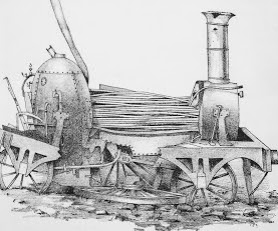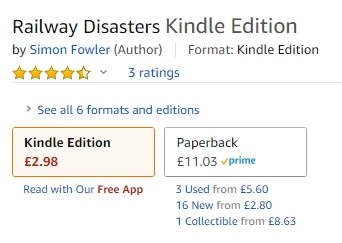fbb's recently acquired railway accident book ...
... splits into two broad sections. The first 37 pages are headed "introduction" but that implies a summary of what is to follow. Simon Fowler's introduction is more an overview of the "development" (if that is the right word) of accidents in the early days of the railways.
Amongst other things, this section examines the problems of running a safe railway without the benefits of modern technology.
The railway "policemen" regulated the the passage of trains by time interval ...
... with problems ably illustrated by this cartoon.
The caption says it all!
Another old cartoon reminds modern readers of the pressures resting on the shoulders of a humble pointsman at a busy station.
The caption may be an exaggeration, but life for the employee was far from easy.
As might be expected, the more lurid press of the day relished a good violent train crash and played consistently on that expectation.
Until a reliable safety valve was invented and widely fitted to steam locomotives, exploding boilers also gave the cartoonists plenty of gory material.
It was not unknown for drivers to be obliged to tighten the valve to get more steam pressure in order to get a heavy train up a hill - with awful consequences!
Early trains were not designed for crash protection - indeed coaches were still largely wood framed well into the 20th Century. Even with steel framework, a sudden impact could well involve a locomotive ploughing through a carriage with consequent loss of life. The picture on the book's front cover actually shows a large steam loco effectively passing through a carriage.
The "cover" accident was at Brentwood, Essex ...
... in 1941.
This "introduction" makes for fascinating reading but the bulk of the book then follows roughly chronolgically.
It consists almost exclusively of drawings or photographs in four sections ...
The Early Railway 1829 to 1889
The Golden Age 1890 to 1914
Years of Way and Peace 1914 to 1947
British Railways 1948 to 1968
... so we are spared some of the tragically memorable "modern" mishaps. Each picture has a thoroughly informative caption and each section had a further short but helpful introduction.
Stasplehurst, the crash involving Charles Dickens and his amour, is there ...
... a crash from which dickens never fully recovered.
Mention is, of course, made of well known accidents like Armagh, Quintinshill and Tay Bridge, but it is the less well known that interest fbb.
How about fish? The contents of fish wagons are here arranged on the station platform at Brocklesby in 1907.
fbb wonders whether the pong was removed before the debris!
The predilection of the Victorians and Edwardians to send and collect postcards is also "commemorated" in one sample card.
The driver and fireman both lost their lives in the above goods train impact at Sharnbrook in Bedfordshire. Whilst today's press and TV news programmes like to show respectful pictures of victims, fbb does not think that today's society would react very happily to the sale of postcards.
Undoubtedly, the best way to enjoy this book is not to absorb fbb's prattling, but to buy the book for yourself.
Other booksellers are available. Whilst considering purchase, blog readers may, as usual, be confounded by the Amazon pricing structure!
Probably the first bad accident that entered into fbb's childhood realm was the Harrow and Wealdstone disaster in 1952. fbb was 7 and was protected from the horror of it, but does remember his parents discussing it in whispers.
Young children were, quite rightly, insulated from very bad news, and very bad it was. 112 persons lost their lives.
Young children were, quite rightly, insulated from very bad news, and very bad it was. 112 persons lost their lives.
fbb was just seven years old.
But back then things were very different. As well as rescue of the injured and respectful removal of the dead, an urgent priority was to get at least some of the through tracks to and from Euston cleared and fit for slow passing.
The accident happened just after 0800 on 8th October. All six lines running through the station were closed including the undamaged slow lines to allow the injured access to ambulances that left from the goods yard.
The slow lines reopened at 5:32 a.m. the following day.
The electric lines were used by cranes to remove the Liverpool locomotives and carriages and reopened 4:30 a.m. on 11 October.
The fast lines were reopened, with a speed restriction, at 8:00 p.m. on 12 October and a temporary footbridge was opened the same evening.
How long would all that take on today's railway?
And you always learn something new.
fbb was intrigued and impressed with this picture from the book.
What is it and where might you have found it?
Answer in tomorrow's blog.
Whoops!
Thanks to John from Sheffield for passing on a picture of a poster in Bristol. It was simply headed "The dangers of slack proof reading".
But our brains are so conditioned to reading what we THINK is in front of us that fbb spent some time researching whether queuing was correctly spelled.
Should it be queueing?
On line sources suggest that both spellings are acceptable, so, thought fbb, what is all the fuss about?
Eventually ...
... the ½40th of a pound finally descended.
And you always learn something new.
fbb was intrigued and impressed with this picture from the book.
What is it and where might you have found it?
Answer in tomorrow's blog.
Whoops!
Thanks to John from Sheffield for passing on a picture of a poster in Bristol. It was simply headed "The dangers of slack proof reading".
But our brains are so conditioned to reading what we THINK is in front of us that fbb spent some time researching whether queuing was correctly spelled.
Should it be queueing?
On line sources suggest that both spellings are acceptable, so, thought fbb, what is all the fuss about?
Eventually ...
... the ½40th of a pound finally descended.
Next Weekend Mixture blog : Saturday 13th June





















No comments:
Post a Comment